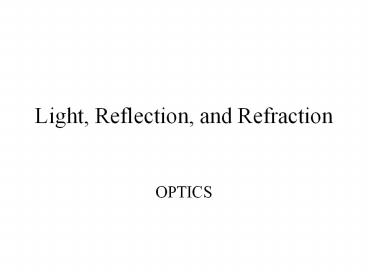Light, Reflection, and Refraction - PowerPoint PPT Presentation
Title:
Light, Reflection, and Refraction
Description:
Light, Reflection, and Refraction OPTICS * * * * * * * * Diverging Lens Diagram Because the rays that enter a diverging lens do not intersect a virtual image is ... – PowerPoint PPT presentation
Number of Views:175
Avg rating:3.0/5.0
Title: Light, Reflection, and Refraction
1
Light, Reflection, and Refraction
- OPTICS
2
Electromagnetic Waves
- Magnetic field wave perpendicular to an electric
field wave - All objects emit EMWs.
- ? Temp ?EMW
- Electromagnetic spectrum
- Range of all frequencies of light
- Visible light is a very small portion of that
entire spectrum.
3
(No Transcript)
4
c
- Speed of Light - 3.00 x 108m/s.
- (wavelength) x (frequency)
- c ?ƒ
5
Visible Light
- Part of the EMS humans can see
- Red - 750nm (x10-9m)
- Purple - 380nm
- Bees, Birds UV
- Snakes IR
6
Reflection
- Light waves usually travel in straight paths
- Change in substance changes direction
- Opaque - does not permit light
- some light reflected
- some light absorbed as heat
7
Reflection
- Texture affects reflection
- Diffuse reflection (rough)
- reflects light in many different directions,
- Specular reflection (smooth)
- reflects light in only one direction
- Smooth variations in surface ? ?
8
(No Transcript)
9
Mirrors
- Light striking a mirror reflects at the same
angle that it struck the mirror
10
Flat Mirrors
- p q
- p- objects distance to the mirror
- q - distance from the mirror to the image
- Virtual image
- Does not exist
- Made by our eyes
11
(No Transcript)
12
Ray Diagrams
- Used to predict the location of the image of an
object
13
Concave Spherical Mirrors
- Reflective surface is on the interior of a curved
surface - C center of curvature
- R Radius (distance to C)
- f Focal Point (1/2 R)
- Principal axis
- any line that passes through C
- usually oriented with an object
14
(No Transcript)
15
Sign of Magnification
Sign of M Orientation of Image Type of Image
Upright Virtual
Inverted Real
16
Concave Spherical Mirror Rules
- A ray traveling through C will reflect back
through C - A ray traveling through (f) will reflect parallel
to the PA - A ray traveling to the intersection of the PA and
the mirror will reflect at the same angle below
the PA. - A ray traveling parallel to PA will reflect
through the focal point
17
Ray Diagrams
- Draw three rays
- The image forms at the point of intersection
- Example
- f 10.0cm
- p 30.0cm
- h 3.00cm
18
Convex Spherical Mirrors
- Reflective surface is on the outside of the
curve. - The points f and C are located behind the mirror
- negative
19
(No Transcript)
20
Rules
- A ray parallel to the PA will reflect directly
away from f. - A ray towards f will reflect parallel to the PA
- A ray towards C will reflect directly away from
C. - A ray to the intersection of PA and mirror will
reflect at the same angle below the OA. - Trace the 3 diverging lines back through the
mirror to reveal the location of the image which
is always virtual
21
(No Transcript)
22
Example
- f -8.00cm
- p 10.0cm
- h 3cm
23
Parabolic Mirrors
- Rays that hit spherical mirrors far away from the
OA often reflect though other points causing
fuzzy images, spherical aberration. - Telescopes use parabolic mirrors as they ALWAYS
focus the rays to a single point.
24
(No Transcript)
25
Refraction
- Substances that are transparent or translucent
allow light to pass though them. - Changes direction of light
- Due to the differences in speed of light
26
Analogy
- A good analogy for refracting light is a
lawnmower traveling from the sidewalk onto mud
27
Index of Refraction (n)
- The ratio of the speed of light in a vacuum to
the speed of light in a medium - ? n - ? c
28
(No Transcript)
29
(No Transcript)
30
(No Transcript)
31
(No Transcript)
32
Thin Lenses
- Converging
- Diverging
- f- curve of lens index of refraction
33
Converging Lens Diagram
- Ray parallel to PA, refracts through far focal
point - Ray through center of lens, continues straight
line - Ray through near focal point, refracts through
lens, continues parallel to PA - Treat lens as though it were a flat plane.
34
(No Transcript)
35
Diverging Lens Diagram
- Because the rays that enter a diverging lens do
not intersect a virtual image is formed by
tracing back the refracted rays. - Ray 1 - parallel to PA, refracts away from near
f, trace back to near f. - Ray 2 - ray toward far f, refracts parallel to
PA, trace back parallel to PA - Ray 3 - ray through center, continues straight,
trace back toward object
36
(No Transcript)































